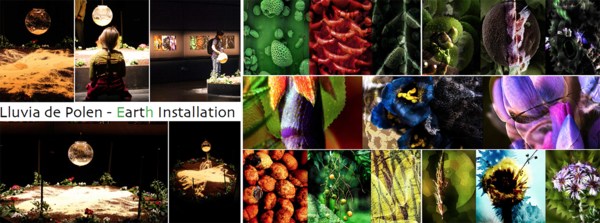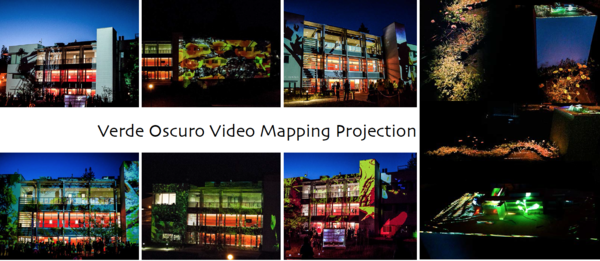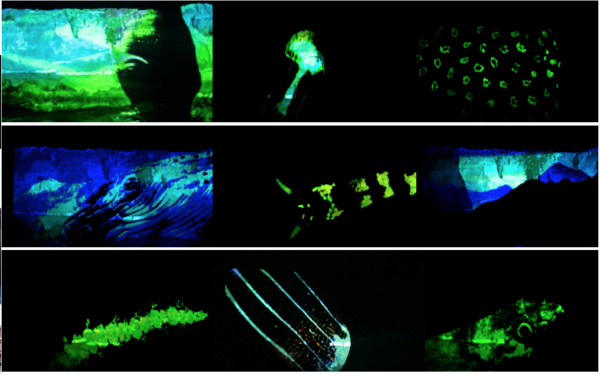User:Catalina/Self Directed/Research
Sky Islands in the Andes Mountains
By
Catalina Giraldo
19th April 2017
As a biologist and visual artist I have been part of different research teams investigating past, present and future ecosystems. My interests have been to understand how the changes in climate have been modifying plants and vegetation through different periods of time and space. Today, my interest is discovering how to transform this knowledge in visual art. For the reason above, I have been exploring installations, video mapping projection and nature photography.
Some of the projects I have worked before took shape between 2011 and 2017 and where supported for many artists and technicians at the University of California, Santa Cruz and the Eye Filmmuseum.
1. Lluvia de Polen. 2011. A collaboration with Holly Findlater
Lluvia de Polen means Pollen rain. It is an art installation that was displayed at the annual open studios at the Research Center in Digital Arts (DARC), University of California, Santa Cruz. The wooden structure shaped beehive cell that evokes the earth and sphere-shaped pendulum hints pollen and pollen rain that takes place on earth at all times. The group of photographs that are part of the installation is based on the different Andean Ecosystems of Colombia.
2. Verde Oscuro. 2013. It is a mapping projection, a metaphor about the ecological history of the place a building occupies today. The piece lasts 13 minutes using video and music that evoke the ecological history of Digital Arts Research Centrer’s place in three eras: the past, the present and the future. While the live plants installation indoors and outdoors intends to create an environment to perceive and feel the inherent goodness of plants, and also to disperse native California plants in order to raise environmental community awareness.
3. Fluctuations. 2014. It is an allegory symbolizing the Ecosystems that occur over a cliff during different periods of time before today. This video mapping projection was part of Bloom Santa Cruz on Saturday April 19th 2014 at Abbott Lighthouse, Santa Cruz, California.
4.Naturalmente. 2017. It is a mapping projection on a balloon, a metaphor about the Earth. It is about the happiness concept in a sense of well-being and connectedness between different species of animals and the environment. (More info here http://www.catalhinagiraldo.com/art-installations)
These works make grow my interest in exploring 3D animation and data visualization as a contemporary tool to imagine ecosystems in time and space. I feel that visual art communication is a powerful instrument to create awareness about the importance of ecosystems, biodiversity and wildlife. In the same way, Science and Arts overlap each other by giving shape to a new creation that enlightens insights, triggers our imagination and helps putting ideas in a new perspective. Especially subjects that are complex in multiple dimensions can highly benefit from the integration between theoretical knowledge and modeling with simulations and science visualization, shaping our sensory experience on something that by definition can neither be touched nor seen (Francoeur, 1997).
That is why today, I am interested in 2D-3D animation and data processing visualization with the aim to create a visualization concerning the changes in Vegetation of the Northern Andes ecosystems for the last two glacial cycles (250.000 years before present). This is a proposal to launch a Science & Art collaborative project that aims at creating a visualization of the Pleistocene geological era history of alpine ecosystems through the use of digital 3D-animation. The story framework is driven by climate change and how the páramo ‘sky islands’ shifted altitudinally along the mountain slopes, heavily influenced by the topography that determined to which degree the páramo got fragmented into isolated patches. I use the ‘páramos’ of the Northern Andes as a case study area, supported by unique long fossil pollen records (e.g. Torres et al., 2005, 2013; Groot et al., 2011, 2013), preliminary work on understanding the spatial dynamics of Andean biomes (Flantua et al., 2014), and previously developed conceptual frameworks (Van der Hammen 1974 , Flantua & Hooghiemstra, 2017).
The difference with other pieces I made before are: first the technological tools I will use, second the focus on a special Ecosystem close to my hearth, and third is a piece based on more than 50 years of research and theories I participate as one of the research team some years ago. This project is expected to have a significant impact in various fields. First of all, decades of knowledge on the evolution in Andean ecosystems will be integrated, providing a much needed interface for multi-disciplinary research between paleoecology, phylogeography, macroecology and paleoclimate. Secondly, strong information graphics will trigger new initiatives in mountain research globally, elucidating the origin of biodiversity in an unprecedented manner. Thirdly, science visualization is increasingly being considered as a vital tool in communicating key scientific development (com pers. Flantua & Hooghiemstra 2017).
Moreover, I am interested in theoretical science fiction and futuristic fictions or visions of the Earth. As well I want to go deep in learning through inspirational artists who are working on a similar topic in the Anthropocene and Environmental Art, and artists exploring the use of the same tools to make their own pieces which could be in another context but still inspiring me. I will continue exploring animation and data visualization, and discovering the integration of photography, video, mapping projection, animation, data visualization in a way to create a piece for the ‘Sky Islands in the Andes Mountains’. The final shape I want to use for this project is an installation which will include a visualization but also physical organisms as soils and plants will be considered. Furthermore, I want to continue exploring projections on different shapes and materials and discover data visualization and infographics as a way of arts and its uses for science.
This is collaboration project with the research team of Palaeoecology at the Institute of Biodiversity and Ecosystem Dynamics, University of Amsterdam, which will be supported by Science PhD. Suzette Flantua and Professor Henry Hooghiemstra. They will provide advice in science research, data and publications that will be the core of the visualization script and story. As well I will have the support of Arts advisors at Piet Zwart Institute as Simon, Barren, Javier, David, Hina, Steve and some professors at Willem de Kooning Academy for data visualization work.
In a larger context sense, the piece would be outlined inside the conceptual movement of artists exploring the metaphorical language of Planet Earth which started in the 70's, like “Planet Earth in Contemporary Electronic Artworks” and “Environmental Art”, which expression coined as an umbrella term to encompass Eco-Art/Ecological Art, Ecoventions, Land Art, Earth Art, Earthworks, and Art in Nature (Knebusch, 2004; Bower 2010). To bring some examples for Environmental Art, there are over 150 artists, and close to 22 scientists and Science & Arts collaborative projects, organizations, programs, and residencies focused on this Eco-Art movement around the world (The Greenmuseum, 2010); a number that have been increasing with the current ‘Art in the Anthropocene”, a massive trans-disciplinary movement of artists, designers and scholars exploring the symbolic language of the Anthropocene (Anthropocene Agents 2017). Artists since the 70’s that have been engaging audiences for climate change, restoration of ecosystems and protection of watersheds using models for sustainable restoration are Newton & Helen Mayer Harrison, AMD&ART/ T., Allan Comp, Jean Paul Ganem, Tim Collins & Reiko Goto, Yolanda Gutiérrez, Patricia Johanson, Lynne Hull, Ichi Ikeda and Aviva Rahmani.
To bring some of the most recent examples of events created to engage audiences for environmental issues in the framework of Anthropocene are:
1) ‘The Great Acceleration: Art in the Anthropocene’ at Taipei Biennale (2014) with the participation of 52 artists (http://www.taipeibiennial.org:8080/index.php/en/). As Bourriaud described (2014), the exhibition addressed the cross-overs appearing in the art of the Anthropocene; it was focused on artists for whom objects, products, computers, screens, chemistry, natural elements or living organisms are interconnected with humans, and can be used by them for a critical analysis of contemporary world. The exhibition highlighted the way artists focus on links, chaining, connections and mutations: how they envision planet earth as a huge network, where new states of matter and new forms of relations appear (Dickinson, 2015; Lin, 2015).
2) ‘7 MIL MILLONES’ (http://www.eacc.es/7-000-000-000/info/) referred to the total human population inhabiting Earth and was hosted at EACC in Valencia, Spain (Alonso, 2015).
3) ‘Dark Ecology project’ (2014, 2015, 2016) inspired by Timothy Morton’s concept of ‘Dark Ecology’ and his philosophy of ‘Ecology without Nature’. Morton offers a radical criticism of the modernist way of thinking about nature as something outside of us and instead proposes an interconnected “mesh” of all living and non-living objects (http://www.darkecology.net/about).
To finish, one of my curiosities are also in Educational Art and its use as a political tool to make Ecosystems design decisions, I believe that visualizing the past we will understand the present and take decisions about the future of the planet. The visualization will be relevant for a very large public including scientists, students, universities, new media artists, schools, policy makers and governments. The final outcome and installation can be displayed in the next biennales Art Science Festivals and Science, Technology and Art Museums.
Bibliography
Alonso C. (2015). Artistic practices, discursive contexts and environmental humanities in the Age of the Anthropocene. Artnodes 15, I ISSN 1695-5951.
Bourriaud, N. (2014). The great acceleration. Art in the Anthropocene. http://www.taipeibiennial.org:8080/index.php/en/tb2014?phpMyAdmin=ef6946252cea3105a72033fb2f279321. (accessed 18-04-2017).
Bower, S. (2010). A Profusion of Terms. Greenmuseum.org. URL: http://greenmuseum.org/generic_content.php?ct_id=306. (accessed 06-04-2017).
Dickinson, B. (2015). Pleistocene, Holocene, Anthropocene. Features 02, ART MONTHLY, Sep 15, 389 pg.
Flantua, S.G.A., Hooghiemstra, H., Van Boxel, J.H., Cabrera, M., González-Carranza, Z., González-Arango, C. (2014). Connectivity dynamics since the Last Glacial Maximum in the northern Andes; a pollen-driven framework to assess potential migration, in: Stevens, W.D., Montiel, O.M., Raven, P.H. (Eds.), Paleobotany and Biogeography: A Festschrift for Alan Graham in His 80th Year. Missouri Botanical Garden, St. Louis, pp. 98–123.
Flantua, S.G.A. & Hooghiemstra, H. (2017) Historical connectivity and mountain biodiversity. In: Hoorn, C., Perrigo, A., Antonelli, A. (eds). Mountains, Climate and Biodiversity. Wiley, Oxford, UK.
Francoeur, E. (1997). The Forgotten Tool: The Design and Use of Molecular Models. Social Studies of Science. 27(1), 7-40.
Groot, M.H.M., Bogotá, R.G. Lourens, L.J., Hooghiemstra, H., Vriend, M., Berrio, J.C., Tuenter, E., Van der Plicht, J.H., Van Geel, B., Ziegler, M., Weber, S.L., and 14 Fúquene Project Members (2011) Ultra-high resolution pollen record from the northern Andes reveals rapid shifts in montane climates within the last two glacial cycles. Climates of the Past 7, 299-316. DOI: 10.5194.cp-7-299-2011.
Groot M.H.M., Hooghiemstra, H., Berrio, J.C., and Giraldo, C. (2013). North Andean environmental and climatic change at orbital to submillennial time-scales: vegetation, water levels and sedimentary regimes from Lake Fúquene 130–27 ka. Review of Palaeobotany and Palynology 197, 186–204.
Knebusch, J. (2004). Planet Earth in Contemporary Electronic Artworks. Leonardo 37 (1), 18-24. URL: http://muse.jhu.edu/journals/len/summary/v037/37.1knebusch.html (accessed 06-04-2017).
Lin, A. (2015). Taipei Biennial: The Great Acceleration. Art Review Issue. Taipei Fine Arts Museum. Jan & Feb 2015. URL: https://artreview.com/reviews/jan_feb_2015_review_taipei_biennial/ (accessed 06-04-2017).
Symposium Agents in the Anthropocene: Trans/disciplinary practices in art and design education today. (2017).Piet Zwart Institute / Willem de Kooning Academy, Rotterdam. January 27-28, 2017. https://www.anthropoceneagents.nl (accessed 04-18-2017).
The Greenmuseum org (2010). URL: http://www.greenmuseum.org/. (accessed 06-04-2017).
Torres, V., Vandenberghe, J., Hooghiemstra, H. (2005). An environmental reconstruction of the sediment infill of the Bogotá basin (Colombia) during the last 3 million years from abiotic and biotic proxies. Palaeogeography, Palaeoclimatology, Palaeoecology 226, 127–148. doi:10.1016/j.palaeo.2005.05.005
Torres, V., Hooghiemstra, H., Lourens, L., Tzedakis, P.C. (2013). Astronomical tuning of long pollen records reveals the dynamic history of montane biomes and lake levels in the tropical high Andes during the Quaternary. Quaternary Science Reviews 63, 59–72. doi:10.1016/j.quascirev.2012.11.004
Van der Hammen, T. (1974) The Pleistocene changes of vegetation and climate in tropical South America. Journal of Biogeography 1, 3-26.



